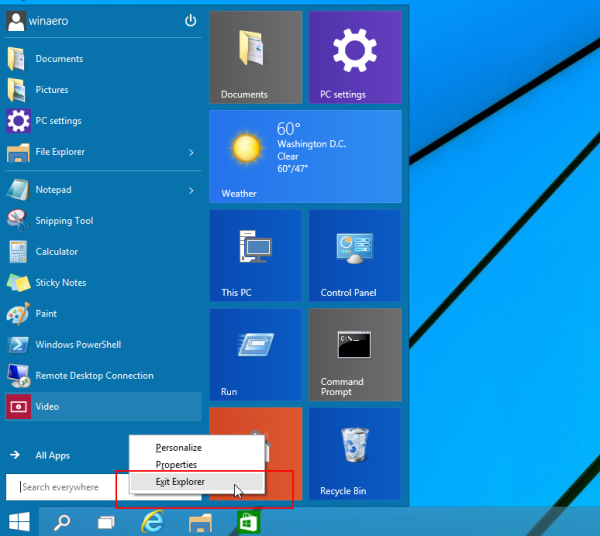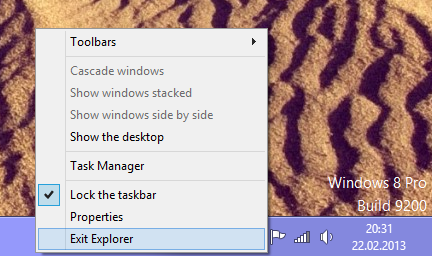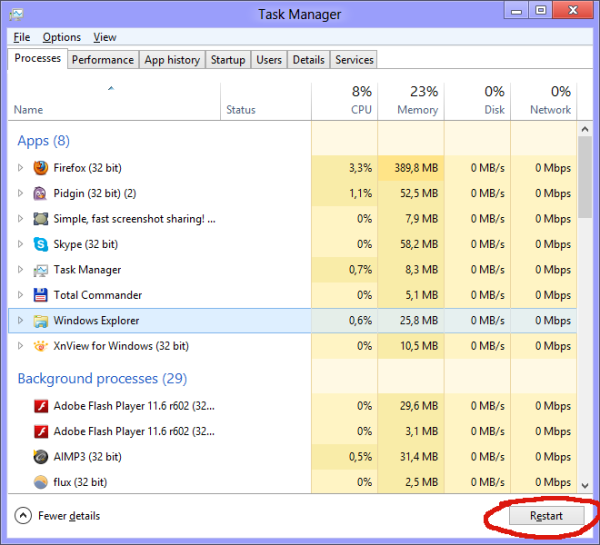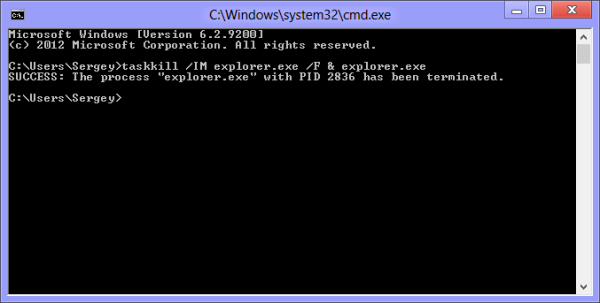Windows provides several secret ways to exit the Explorer shell. They can be useful when you make registry changes that affect Explorer or for shell developers when testing shell extensions. In case you didn't know them, today I am going to share them with you.
Why you may want to restart Explorer
There are several reasons when you may want to exit the Explorer shell and start it again, such as:
- You are trying to uninstall some software with shell extensions, e.g. WinRAR. If you leave Explorer, all shell extensions will be unloaded from the shell and will be cleanly deleted by the uninstaller. All files that are locked for use by the Explorer.exe process will be released.
- If you applied some tweak which requires you to log off and log in back, in most cases, it is enough to only restart the shell.
Let's see how this can be done.
Advertisеment
On Windows 8, press and hold Ctrl+Shift keys on your keyboard and right click on an empty area of the Taskbar. Viola, you just got access to a hidden context menu item: "Exit Explorer".
Windows 10 has a similar "Exit Explorer" option for the taskbar.
Additionally, it has the same command "Exit Explorer" in the context menu of the Start menu, as Windows 7 used to have:
- Open the Start menu in Windows 10.
- Press and hold Ctrl + Shift keys and right click the Start menu.
- The extra item will appear in the context menu, from there you can properly exit the Explorer shell:

In Windows 7 and Vista, you can hold down Ctrl+Shift and right click on an empty area of the Start Menu to access "Exit Explorer".
To start Explorer again, press Ctrl+Shift+Esc to start the Task Manager, and use File -> New task menu item in Task Manager. Type Explorer in the "Create New Task" dialog and press Enter.
Method 2: Use the secret method to exit Explorer via the classic shutdown dialog
Select anything on your Desktop, e.g. any shortcut, then press Alt+F4. The "Shut Down Windows" dialog will appear.
Press and hold Ctrl+Alt+Shift keys on your keyboard and click the "Cancel" button:
This will also exit the Windows Shell. To start Explorer again, press Ctrl+Shift+Esc to start the Task Manager, and use File -> New task menu item in Task Manager. Type Explorer in the "Create New Task" dialog and press Enter.
Note: This method also works in all previous versions of Windows, all the way back to Windows 95, when the NewShell was introduced.
Method 3: Use Windows 8's Task Manager, Luke
Open your Windows 8 Task Manager using Ctrl+Shift+Esc keys. Note that if you have restored the good old classic Task Manager using one of our previous tips, you won't be able to use this method.
Find the "Windows Explorer" application on the "Processes" tab. Select it. The "End Task" button on the bottom-right corner will turn into "Restart". Or right click "Windows Explorer", and choose Restart.
Method 4: Kill'em all
There is a 'taskkill' command line tool in Windows which allows you to kill processes. To kill Explorer, the command line must be as follows:
taskkill /IM explorer.exe /F
IM here stands for Image name, and F stands for force. To start Explorer again, press Ctrl+Shift+Esc to start "Task manager, open File menu -> New task. Type Explorer in the "Create new task" dialog and press Enter.
Tip: You can combine Taskkill and Explorer.exe commands on one line to perform a restart of the Windows Shell. Use the following command in batch file or in the command window:
taskkill /IM explorer.exe /F & explorer.exe
This is the worst method of them all because it terminates Explorer forcibly. Every time you use taskkill, Explorer will not save its settings, e.g. arrangement of icons on Desktop. Avoid using it, and use the initial three methods mentioned above.
You can see all four methods in the following video:
Support us
Winaero greatly relies on your support. You can help the site keep bringing you interesting and useful content and software by using these options:





Thanks for highlighting all these hidden shotrcuts, didn’t know any of them except the taskkill method!
How can I start Explorer with system privileges?
How to run Explorer as administrator on Windows 8.1, Windows 8 and Windows 7
Worked perfectly. THANK YOU!
There is this one as well (PowerShell):
(Get-Process -Name Explorer) | Stop-Process
Hmm, cool, really new way for me.
Thanks for sharing.
Thank you for this PowerShell command: (Get-Process -Name Explorer) | Stop-Process
I think that the best way to restart explorer.exe in a batch for windows 8.1 . We can call PowerShell to run that command in CMD by this:
PowerShell.exe -Command “”
I really like the Restart method in the Task Manager. Does the whole restart reliably. All developers should know this.
David Spector
Springtime Software
Taskkill needs WMI service running. Is there a way to do i without this service?
After I tried to fix the right problem, I think I did something wrong and it gives me black screen I can’t fix it
Еще один вариант — создать ярлык с параметрами: cmd.exe /c taskkill /IM explorer.exe /F & start explorer.exe
The CMD version doesn’t work.
Explorer gets killed but when it runs explorer.exe only the explorer window opens and not the whole taskbar.
Tested on Windows 10.
I added also a sleep between kill and run but with same result.
It looks like some explorer.exe process remains running in memory.
Can you check it with tasklist or task manager?
Thanks for this interesting post. But for me the CMD version does not work for deployment of windows images because it kills all related background tasks.
after i use taskkill /IM explorer.exe /F & explorer.exe in command prompt, start menu no longer works in windows 10!!!
Perfect. Thanks
You can also make a .bat file to easily do it.
1. Open Notepad (Windows+R. Then type “notepad”)
2.Copy this text into Notepad (Ctrl+C):
taskkill /f /IM explorer.exe
start explorer.exe
exit
3. Go to File>Save As
4. Type in any name with the extension of .bat. Make sure to remove the .txt at the end. (EX: Restart Explorer.bat)
5. Save it
6. Find the file, double-click it.
7. Done :)
One more way to restart the Windows Explorer process with PowerShell
Stop-Process -ProcessName Explorer -Force
Nice tip! Thanks for sharing.
For all who interest in blocking combination of keys: Ex: you want to block Windows + Shift + S, just type in S. That will block both Windows + S and Windows + Shift + S.
My PC recently lost the entire Windows 10 start menu after installing utilities from the motherboard’s manufacturer. No approach was working, until I found your guidance on simply exiting Explorer – which worked perfectly.
Thank you!
More simple execute (this restart explorer.exe directly):
tskill explorer
On Win + R, or Search bar, or Windows Explorer, etc